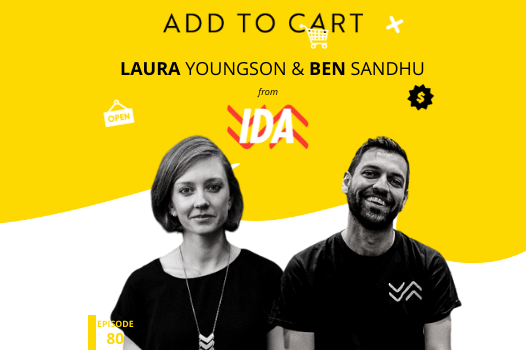In this episode of Add To Cart, we are joined by Laura Youngson and Ben Sandhu from Ida Sports, who have created the first football boot specifically designed for women’s feet. Only a couple of years old, they have grown from an idea on the back of a napkin and an early prototype they called the ‘frankenshoe’, to selling out of their first range, getting stocked in Dicks Sporting Goods and having Isabel Dawes kick a goal in the AFLW grand final wearing their shoe. In this chat, we hear how Ben and Laura used LinkedIn as an outreach tool, why their first crowdfunding campaign failed miserably and how removing barriers to entry for women in sport is their ultimate goal.
“Once you feel it, you can’t unfeel it and it’s magical once you get something that actually works for you.“
Laura Youngson
Questions answered in this episode include…
- What are some of the key differences between men and women’s needs in a sports shoe?
- How did you go about designing a women’s football boot from scratch?
- What are some of the most significant barriers to entry for women in sport?
Beyond ‘shrink it and pink it’
(Laura) “It’s putting women at the heart of the design process, which I think has been kind of overlooked up until now. It happens a little bit. But actually, it’s an open secret in the industry that they kind of ‘shrink it and pink it’. Let’s take a man’s shoe and just squash it down a bit and slap some pink on it, and that would be great for women. Let’s go. And actually for us, that’s not good enough.
And I think taking female athletes, putting them at the center of the experience, and then designing literally from…female’s feet are different. So then you look at, okay, can we make the shape different? And then can we make the design actually look cool so that you could go to the pub in them? And you’re building things that are really made for the athletes that are going to be wearing them.”
(Ben) “I mean, in a nutshell, it’s not treating women as an afterthought in an industry that is prone to doing that time and time again, really.”
Designing for women’s feet – because they’re different
(Laura) “I think one of the things we see that really kind of blew my mind, and explained a lot of the reasons about some of the experiences I was having as a player, is things like women tend to have narrower heels just all the way through. You can end up getting blisters on your heel because they kind of slop around. We tend to have different ratio around our toes. Where the widest point of our foot is, it’s actually kind of further back compared to men. That means your little toe gets squished in, and you get all these blisters. And you can also get, I call it ‘squishy toe’, where you get black toenails, things like that.
I keep finding things out like we have higher arches, we need a bit more support through the mid foot, our hips are slightly further apart where your pressure load is different. What that means is the outsole, and when you’re making that running movement, that will need to change.
And once you start kind of correcting for those differences, you put your foot into a female made boot, and you’re like, whoa, this is what all shoes should feel like. I’ve got really kind of strict about it, because if I wear a unisex shoe then I’m like, “No, this feels so wrong.” It’s one of those things that once you feel it, you can’t unfeel it.. It’s magical once you get something that actually works for you.”
Shoe dog
(Ben) “Where we started was, I remember going on LinkedIn and just messaging anybody with footwear in their job description and just being like, “Can I buy you a coffee? I want to ask you everything about what you know.” And we were super lucky with some of the people that got back to us with lots of experience that found the problem we were exploring really interesting and wanted to help. That’s how I approached it in the beginning.”
(Laura) “Then we made a shoe in the kitchen. We properly went ‘shoe dog’ on it. And just found some TPU which is what you make out soles from. Made a mold from my current shoes. Made our first prototype. We got it stitched together by the guy that makes boots in downtown Melbourne. And I took it for a test run. And that was enough to kind of kickstart us and get us going to go, ok there’s a market for this.”


